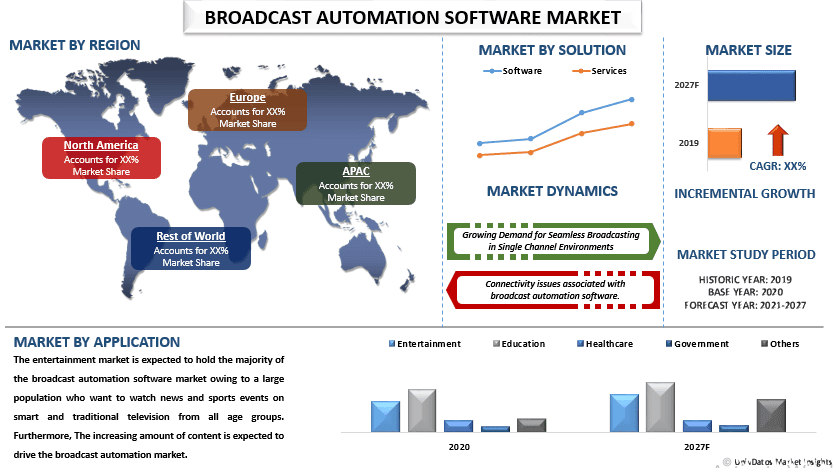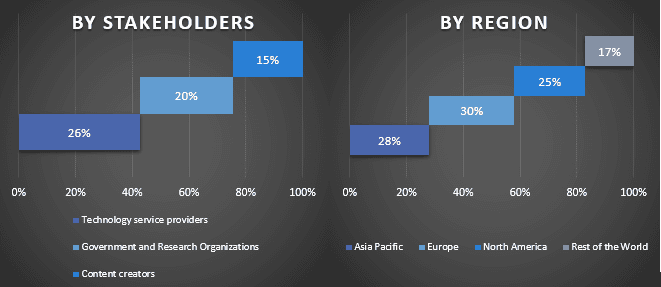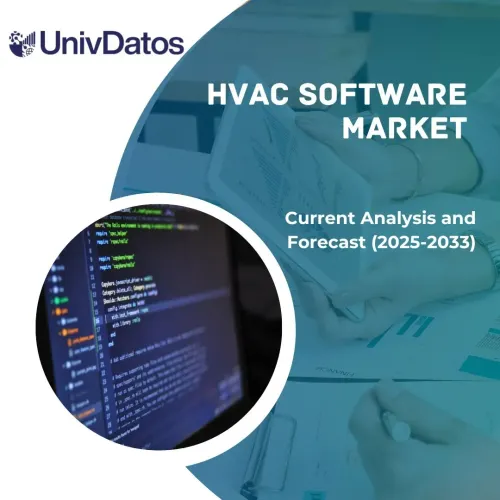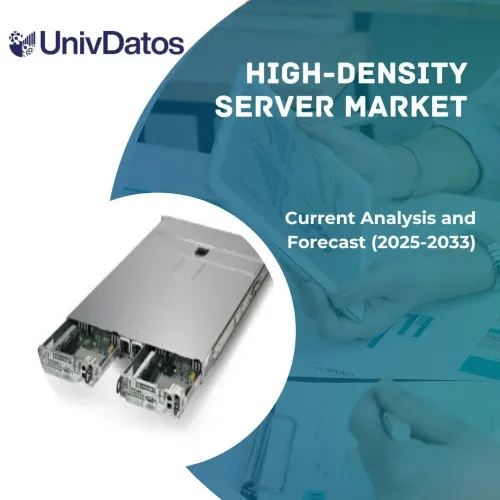放送自動化ソフトウェア市場:現状分析と予測 (2021年~2027年)
製品重視(Webベース、クラウドベース、ハイブリッド);ソリューション(ソフトウェア、サービス);アプリケーション(エンターテインメント、教育、ヘルスケア、政府機関、その他);地域/国

ブロードキャスト自動化ソフトウェア市場は、予測期間中に10%のCAGRで成長すると予想されています。放送メディア計画における複雑性の増大と、クラウドベースのソリューションの採用の増加が、予測期間中の市場成長を牽引する主な要因と予想されます。さらに、マルチメディアストリーミングアプリケーションとスマートデバイスの需要の増加も、市場の成長を促進すると予想されます。さらに、より優れたユーザーエクスペリエンスを実現するために、ブロードキャスト自動化ソフトウェアは、改善されたTVプログラミングと計画を支援します。この成長は、シングルチャネル環境でのシームレスな放送に対する需要の高まりと、世界中でのマルチメディアストリーミングアプリケーションの人気の上昇に起因しています。放送計画に関する制作、放送部門、広告のワークフローは、ブロードキャスト自動化ソフトウェアによって管理されます。
レポートで提示される洞察
「製品別では、ハイブリッドセグメントが予測期間中に最も高いCAGRを示すと予想されます」
製品に基づいて、市場はウェブベース、クラウドベース、およびハイブリッドに分類されます。ハイブリッドセグメントは、オンラインおよびストリーミングメディアプラットフォームに対する消費者の嗜好の変化により、ブロードキャスト自動化ソフトウェア市場の大部分を占めると予想されています。さらに、さまざまな国での採用率の増加と、ハイブリッド展開によって提供される高い柔軟性、費用対効果、および放送コンテンツへのリアルタイムアクセスも、将来のセグメントの成長を促進すると予測されています。
「ソリューション別では、サービスセグメントが予測期間中に最も高いCAGRを示すと予想されます」
ソリューションに基づいて、市場はソフトウェアとサービスに分類されます。サービス市場は、ブロードキャスト自動化ソフトウェア市場の大部分を占めると予想されています。ラジオおよびテレビ放送局からの放送管理および自動化ソリューションの需要の増加は、このセグメントの成長に貢献する主な要因です。また、幅広いアプリケーションと専門知識が提供されます。統合およびホスティングサービスに対する需要の増加も、このセグメントの成長を促進すると予想されます。
「アプリケーション別では、エンターテインメントセグメントが予測期間中に最も高いCAGRを示すと予想されます」
アプリケーションに基づいて、市場はエンターテインメント、教育、ヘルスケア、政府、その他に分類されます。エンターテインメント市場は、ラジオおよびテレビ放送局からの放送管理および自動化ソリューションの需要の増加により、ブロードキャスト自動化ソフトウェア市場の大部分を占めると予想されています。さらに、すべての年齢層からのニュースやスポーツイベントをスマートテレビや従来のテレビで見たいと考える多くの人々も要因です。
「アジア太平洋地域は、予測期間中に著しい成長を遂げると予想されます」
アジア太平洋地域は、予測期間中に注目すべき成長を遂げると予想されます。高度な技術の採用の増加と、この地域に多数のテレビ世帯が存在すること、およびこの地域の都市人口の所得の増加により、ブロードキャスト自動化ソフトウェア市場が牽引されると予想されます。さらに、主要な市場プレーヤーの存在と、新技術の開発および研究開発への投資の増加により、ブロードキャスト自動化市場が牽引されると予想されます。
このレポートを購入する理由:
- この調査には、認証済みの主要な業界専門家によって検証された市場規模と予測分析が含まれています。
- このレポートは、業界全体のパフォーマンスの概要を一目で示します。
- このレポートは、主要なビジネス財務、製品ポートフォリオ、拡大戦略、および最近の動向に重点を置いて、著名な業界ピアの詳細な分析を網羅しています。
- 業界で普及している推進要因、制約、主要なトレンド、および機会の詳細な調査。
- この調査では、さまざまなセグメントにわたる市場を包括的に網羅しています。
- 業界の地域レベルの詳細な分析。
カスタマイズオプション:
世界のブロードキャスト自動化ソフトウェア市場は、要件またはその他の市場セグメントに応じて、さらにカスタマイズできます。これに加えて、UMI はお客様独自のビジネスニーズがあることを理解しているため、お客様の要件に完全に適合するレポートを入手するために、お気軽にお問い合わせください。
価格表?
目次
グローバル放送自動化ソフトウェア市場分析(2021年~2027年)の調査方法
グローバル放送自動化ソフトウェア市場の過去の市場を分析し、現在の市場を推定し、将来の市場を予測することは、主要地域における放送自動化ソフトウェアの採用を構築および分析するために行われた3つの主要なステップでした。過去の市場規模データを収集し、現在の市場規模を推定するために、徹底的な二次調査が実施されました。次に、これらの洞察を検証するために、数多くの調査結果と仮定が考慮されました。さらに、グローバル放送自動化ソフトウェア市場のバリューチェーン全体の業界専門家との徹底的な一次インタビューも実施されました。一次インタビューを通じて市場規模データの仮定と検証後、トップダウン/ボトムアップアプローチを採用して、市場全体の規模を予測しました。その後、市場の内訳とデータの三角測量方法を採用して、業界に関連するセグメントおよびサブセグメントの市場規模を推定および分析しました。詳細な方法論については、以下で説明します。
過去の市場規模の分析
ステップ 1:二次資料の詳細な調査:
放送自動化ソフトウェア市場の過去の市場規模を取得するために、年次報告書および財務諸表、業績プレゼンテーション、プレスリリースなどの企業内部情報源や、ジャーナル、ニュースおよび記事、政府刊行物、競合他社の刊行物、セクターレポート、サードパーティデータベース、その他の信頼できる刊行物などの外部情報源を通じて詳細な二次調査を実施しました。
ステップ 2:市場セグメンテーション:
放送自動化ソフトウェア市場の過去の市場規模を取得した後、主要地域のさまざまなセグメントおよびサブセグメントに関する過去の市場の洞察とシェアを収集するために、詳細な二次分析を実施しました。主要なセグメントは、製品、ソリューション、およびアプリケーションとしてレポートに含まれています。さらに、その地域におけるテストモデルの全体的な採用を評価するために、国レベルの分析を実施しました。
ステップ 3:要因分析:
さまざまなセグメントおよびサブセグメントの過去の市場規模を取得した後、放送自動化ソフトウェア市場の現在の市場規模を推定するために、詳細な要因分析を実施しました。さらに、放送自動化ソフトウェアのさまざまな製品、ソリューション、およびアプリケーションなどの従属変数と独立変数を使用して要因分析を実施しました。世界中の放送自動化ソフトウェア市場セクターにおけるトップパートナーシップ、合併と買収、事業拡大、および製品の発売を考慮して、需要と供給側のシナリオについて徹底的な分析を実施しました。
現在の市場規模の推定と予測
現在の市場規模:上記の3つのステップからの実行可能な洞察に基づいて、現在の市場規模、グローバル放送自動化ソフトウェア市場の主要プレーヤー、およびセグメントの市場シェアに到達しました。必要なすべてのパーセンテージシェア分割と市場の内訳は、上記の二次的アプローチを使用して決定され、一次インタビューを通じて検証されました。
推定と予測:市場の推定と予測のために、推進要因とトレンド、制約、および関係者が利用できる機会を含むさまざまな要因に重みが割り当てられました。これらの要因を分析した後、関連する予測手法、つまりトップダウン/ボトムアップアプローチを適用して、グローバルな主要市場全体のさまざまなセグメントおよびサブセグメントについて2027年頃の市場予測に到達しました。市場規模を推定するために採用された調査方法には、以下が含まれます。
- 収益(米ドル)の観点からの業界の市場規模、および国内の主要市場全体での放送自動化ソフトウェア市場の採用率
- 市場セグメントおよびサブセグメントのすべてのパーセンテージシェア、分割、および内訳
- 提供されるソリューションの観点から見た、グローバル放送自動化ソフトウェア市場の主要プレーヤー。また、急速に成長する市場で競争するためにこれらのプレーヤーが採用する成長戦略
市場規模とシェアの検証
一次調査:主要地域全体のトップレベルのエグゼクティブ(CXO / VP、営業部長、マーケティング部長、オペレーション部長、および地域部長、カントリーヘッドなど)を含む主要オピニオンリーダー(KOL)との詳細なインタビューが実施されました。次に、一次調査の結果を要約し、統計分析を実施して、述べられた仮説を証明しました。一次調査からのインプットは二次的な調査結果と統合され、情報が実行可能な洞察に変わりました。
さまざまな地域における一次参加者の分割

市場エンジニアリング
データ三角測量手法を採用して、市場全体の推定を完了し、グローバル放送自動化ソフトウェア市場の各セグメントおよびサブセグメントの正確な統計数値を導き出しました。グローバル放送自動化ソフトウェア市場における製品、ソリューション、およびアプリケーションの分野におけるさまざまなパラメーターとトレンドを調査した後、データをいくつかのセグメントおよびサブセグメントに分割しました。
グローバル放送自動化ソフトウェア市場調査の主な目的
グローバル放送自動化ソフトウェア市場の現在および将来の市場動向が調査で明確に示されました。投資家は、調査で実施された定性的および定量的分析に基づいて、投資に関する裁量を判断するための戦略的洞察を得ることができます。現在および将来の市場動向は、地域レベルでの市場の全体的な魅力を決定し、産業参加者が未開拓の市場を活用して、先行者利益から恩恵を受けるためのプラットフォームを提供しました。調査のその他の定量的な目標には、次のものがあります。
- 価値(米ドル)の観点から、放送自動化ソフトウェア市場の現在および予測市場規模を分析します。また、さまざまなセグメントおよびサブセグメントの現在および予測市場規模を分析します。
- 調査のセグメントには、製品、ソリューション、およびアプリケーションの領域が含まれます。
- 放送自動化ソフトウェア市場業界の規制フレームワークの定義と分析。
- 業界の顧客と競合他社の行動を分析するとともに、さまざまな仲介業者の存在に関連するバリューチェーンを分析します。
- 主要地域における放送自動化ソフトウェア市場の現在および予測市場規模を分析します。
- レポートで調査された地域の主要国には、アジア太平洋、ヨーロッパ、北米、および世界のその他の地域が含まれます。
- 放送自動化ソフトウェア市場の企業プロファイル、および急速に成長する市場で持続するために市場プレーヤーが採用する成長戦略
- 業界の詳細な地域レベルの分析
関連 レポート
この商品を購入したお客様はこれも購入しました










